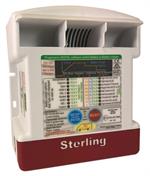Some of this voltage topic may not be specific to alternator charging, but for more general info.
Personally, my usual stop-charge voltage setting for charging LFP is 3.45Vpc, which for 4S "12V" packs = 13.8V max. Note that is usually at an amps rate of .2 - .3C (.3C = 30A charge current per 100AH bank size). At higher rates, to shorten ICE run-times, it is safe to go to 3.5Vpc / 14.0V.
Note even at the "low" max charge voltage, letting the charge source continue to "push" even low currents long **past** the endAmps point is over-charging, in the sense of reducing potential lifecycles.
At low charge rates, as with many solar setups, under say 0.2C, I reduce termination voltage down to 3.40Vpc / 13.6V.
If your charge rate is **very** low, below say 0.05C, or very variable above and below that ballpark, then you are in real danger of overcharging - even at that seemingly low voltage of 3.40Vpc / 13.6V. In fact, monitoring voltage while charging will not even be meaningful wrt SoC.
_____
There are times and reasons when you need to go to higher voltages for a while - poorly designed balancing gear with low balance current rates that require a (too-)high CV/Absorb voltage be held for a (too) long time, wiping out lost capacity from a so-called "memory effect".
And over the very many years you own your very expensive LFP bank, there may emerge hard proof that a change in charge profile will yield even more hundreds or even thousands of cycles.
TL;DR I would never let any charge source without user-custom adjustable voltage setpoints and Absorb Hold Time charge an LFP bank.
Furthermore, with LFP's crazy high CAR specs, you will either damage the alt / diodes or charge the bank at too high an amps rate, or both.
Adjustable current limiting is a must, and not by relying on too-thin a gauge of wire, or inaccurate diodes/resistors.
Also the ability to automatically derate the output current when the alt or its electronics start to get too hot.




